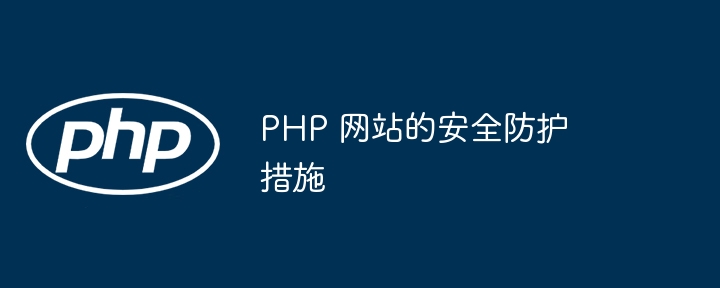Home >Backend Development >PHP Tutorial >Security measures for PHP websites
Security measures for PHP websites
- WBOYWBOYWBOYWBOYWBOYWBOYWBOYWBOYWBOYWBOYWBOYWBOYWBOriginal
- 2024-05-02 16:45:021084browse

PHP website security protection measures
Introduction
It is crucial to protect your website from cyber threats important. For PHP websites, taking appropriate security measures is key to maintaining data and user trust. This article will explore a series of effective and practical PHP security protection measures and provide practical case illustrations.
1. Input validation
- Purpose: Prevent malicious input from causing code execution or SQL injection attacks.
-
Method: Use built-in PHP functions (such as
filter_input()) or third-party libraries (such ashtmlpurifier) to verify user input and filter out Malicious characters and HTML code.
Actual case:
<?php
// 验证用户姓名
if (!filter_var($_POST['name'], FILTER_SANITIZE_STRING)) {
die("Invalid name");
}2. Output encoding
- Purpose:Encode sensitive data (such as passwords) into an unreadable format to prevent XSS attacks.
-
Method: Use the
htmlspecialchars()oresc_html()function to encode the data to be output.
Practical case:
<?php // 输出编码的密码 echo htmlspecialchars($password);
3. Hash and salt
- Purpose: Store passwords securely so that they cannot be recovered even if the database is leaked.
-
Method: Use the
password_hash()function to hash the password and add random characters (salted) before the hash value.
Practical case:
<?php // 哈希和加盐密码 $hashedPassword = password_hash($password, PASSWORD_DEFAULT);
4. CSRF protection
- ##Purpose:Prevent cross-site request forgery attacks, which exploit a user's authentication to perform unauthorized actions.
- Method: Use synchronization token or CSRF middleware to verify whether the request comes from a trusted source.
Practical case:
// 检查 CSRF 令牌
if ($_POST['csrf_token'] !== $_SESSION['csrf_token']) {
die("Invalid CSRF token");
}
5. Head safety
- Purpose: Protect websites from common attacks such as cross-domain scripting attacks and information leakage.
- How to: Set security headers in the response HTTP headers (e.g. X-Frame-Options
,Content-Security-Policy) , to restrict cross-domain access and malicious scripts.
Practical case:
<?php
header("X-Frame-Options: SAMEORIGIN");
header("Content-Security-Policy: default-src 'self'");
6. Logging and monitoring
- Purpose :Monitor website activity, detect and respond to security incidents.
- How to: Set up a logging and monitoring system to record errors, suspicious activity, and successful login attempts.
Practical case:
// 设置日志记录系统
$fp = fopen('application.log', 'a');
fwrite($fp, "Login attempt from " . $_SERVER['REMOTE_ADDR'] . "\n");
Conclusion
By implementing these security protection measures, PHP websites can significantly Reduce the risk of cyber threats and maintain data security and user trust. It is critical to regularly review and update security measures to respond to the ever-changing cybersecurity environment.The above is the detailed content of Security measures for PHP websites. For more information, please follow other related articles on the PHP Chinese website!

